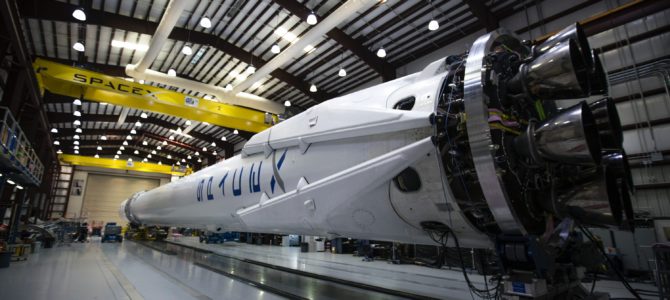
On Saturday afternoon, the Florida thunderstorms broke just long enough for history to be made. After 10 years of slow and sometimes painful change, NASA finally took the historic step of taking an astronaut into orbit in a private spacecraft.
While discussion of this remarkable event has been overshadowed by riots and lockdowns occurring across the US, the importance of this launch cannot be understated. It shows the success of an unprecedented policy of privatization, with immense, positive consequences on the future of space travel.
For 10 years, the United States has been left to rely on Russia to access outer space since the end of the shuttle program. Politicians always knew a replacement would be needed; yet the government’s lack of long-term planning led to the incomplete development then collapse of eight different alternatives.
When the shuttle program finally ended, NASA was left little closer than we were at the start. As much as we should respect the engineers at NASA, they are ultimately ordered by politicians and bureaucrats in DC and suffer from it just as any government project does. Russian reliance was meant to be a band-aid for this problem, but it quickly became much more of a crutch.
For those hoping to see continued leaps in space travel, particularly with the United States at its head, this slow-motion political wipe-out has been a historic setback. It hasn’t ended either; after Bush’s program was cancelled by the Obama Administration, we’ve since pumped billions into yet another distant shuttle alternative, the SLS (Space Launch System).
A New Approach
Trapped in a state of dependence, NASA tried what must have seemed like a Hail Mary at the time- vertical privatization. There had always been a recognition of private industry’s invaluable role in creating parts of high-tech rockets, but contractors had little freedom, with everything organized along government specifications. This Hail Mary, the Commercial Crew Program, or CCP, turned this old order on its head by contracting high-performing companies to design almost every level of the next generation of rockets, with far less regulation and meddling. Two firms were selected after a fierce competition: military-industrial giant Boeing, and a relatively new, thus far entirely independent, SpaceX.
Things didn’t just go cleanly from there; politicians consistently squirmed about going private, preferring to keep politically profitable projects in their district backyards. But after a SpaceX Falcon 9 (yes, it’s named after the Millennium Falcon) carried astronauts into orbit on a rocket entirely built in and launched from the United States this weekend, the CCP can be called the remarkable success it is.
Restoring manned space travel to the US is only part of this. American rockets are now three times cheaper than the Russian alternatives, and seven times cheaper than a space shuttle launch. Perhaps most importantly, it shifted the market from one of state dominance with politically connected military-industrial giants gobbling up contracts, to one of relative market freedom centered around two competing firms.
Three Big Implications of The Historic Launch
This story doesn’t end here. The rise of near-total privatization as a successful strategy for American space exploration has three big implications for the future.
First, SpaceX taking the crown means privatization is unlikely to end and has a major role to play in the coming years, as Lunar and Martian goals come closer. Trump has already taken steps to privatize aspects of the next stage of American exploration, the return to the moon with the Artemis Program, but NASA is still planning on using its costly and unfinished SLS for the job. This may be about to change.
With ballooning costs and 18 years of stunted development, it’s fair to question why the government should continue dedicating tens of billions to the program while SpaceX’s entire lunar rocket, the Starship, has a price tag less than the SLS’s engine contract alone. Saturday’s events demonstrated the effectiveness of broadly privatized launches, and gives hope for cheaper, more efficient space travel in the near future.
Yet for every winner there is a loser, and today’s loser was Russia. For ten years, the US and the rest of the international community has relied on Rosmocosmos, the Russian space agency, to access outer space. In addition to providing funding, it’s not hard to see why American reliance on Russian technology was an excellent propaganda point for the Kremlin. With the success of the Commercial Crew Program, that’s over. Furthermore, with SpaceX Falcon 9 rockets being far cheaper than the Russian Soyuz rockets, many international partners will begin to transition back to American suppliers. We’re already beginning to see this, with Japan entering an international partnership to use the Falcon 9 as a replacement for Soyuz this August.
Finally, while it has largely stayed out of the news, the launch marks the end of a decade-long space race between SpaceX and Boeing for the first manned launch. Elon Musk’s smaller and more independent company bested the military-industrial Goliath by a country mile, gaining public legitimacy and media attention with it. In light of this loss, its higher price tags, and its recent high-profile failure, Boeing will have to greatly improve its operations to participate in the next stage of American space travel, namely the Artemis Program.
The success of NASA’s privatization program shows the American free market system working at its best. The return of American space travel from Cape Canaveral this weekend shows that a smaller, independent company with a better product can beat its bloated, politically connected rival, upset the international status quo and bring an interplanetary future one step closer. There is a message of hope to be gleaned from this, both about the future of space exploration, and that of the American system as a whole.









